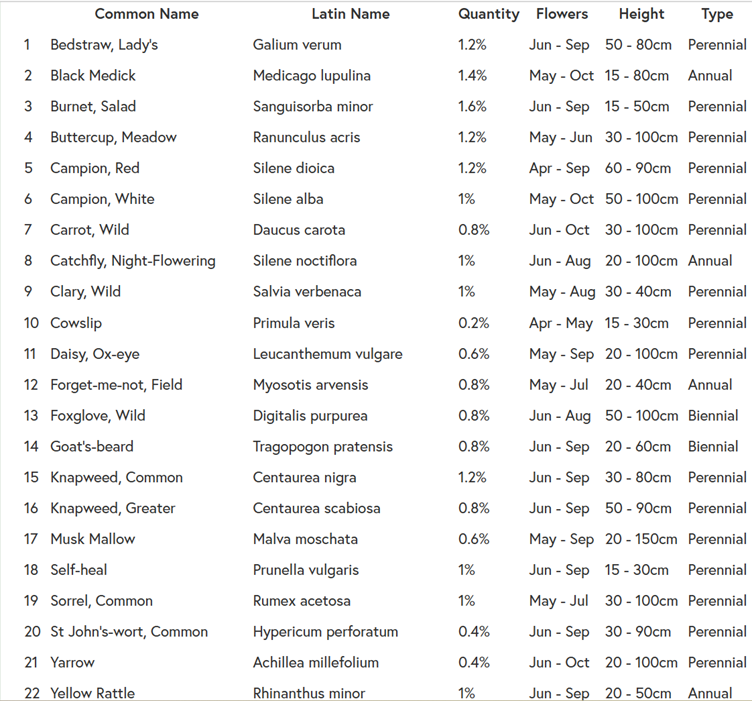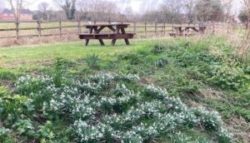Aim: To plant bulbs and wild flowers in open spaces all around the Village to improve appearance and encourage insects.
Progress as of July 2023: Planting of bulbs has been going on for quite a few years now so keep an eye open for what pops up around the Village this spring. We are working with the groundwork operators from NE Lincs to prevent too many of them being cut down while mowing the grass and trimming hedges.
Odd corners of otherwise unused land are being adapted for flowers on an individual basis such as this one in Poplar Road.
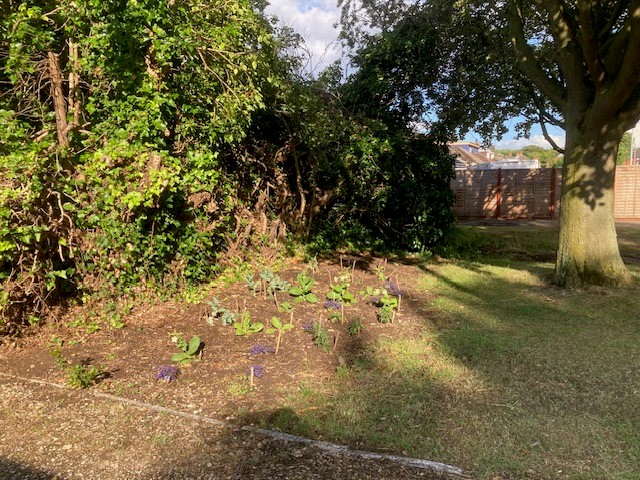
Meadow Farm held an open day on 2nd of July 2023. This included a tour and lots of information on the development of a wild flower meadow and natural planting around the verges that is currently in progress there. They also raised a very good amount for the St Andrews Hospice fund. Stephen Jones produced the following write-up.
WILD FLOWERS
We have several, set aside areas that feature a mix of grasses and wild flowers, and blackthorn, and blackberries and a mix of native trees. These support a range of wild life: shrews, rabbits, squirrels, foxes, occasional deer, many types of birds, frogs and toads, and many types of insects from leaf cutter bees to grasshoppers. The top meadow this year is full of butterflies and if you look hard grasshoppers, rabbits , shrews, foxes.
This year we started a trials area to understand what wild flowers will thrive best with what planting approach.
We all think of a wildflower meadow like this:
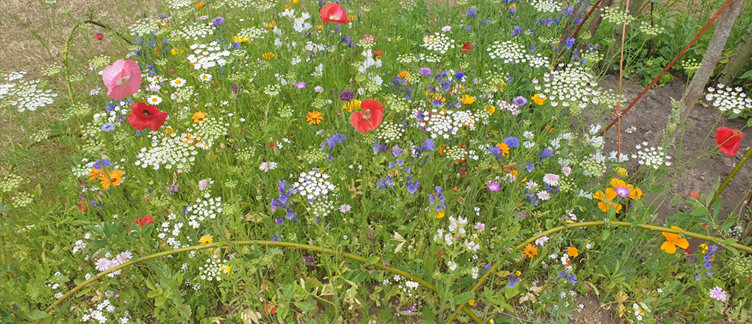
This photograph is of a section of a small plot at the base of the sweet peas in the RHS Wisley trials area – i.e. limited width, good soil and no grass and not like many meadows you see in the UK countryside.
There are reason why the local fields are not full of cornflowers, corncockles, candytuft, poppies etc. The soil here is heavy clay, the climate is dryer than the south west and more prone to winter frosts and N.E. Winds, and perennials and grass crowd them out. They often appear in poor soil where there is less competition.
We have really heavy clay here, yet we’re surrounded by some really lovely meadows. People are surprised, but they shouldn’t be. Some clay soils can have fertility higher than ideal, our soil is pretty good for meadow making. These soils are typically pretty neutral in terms of pH and do sometimes get waterlogged, but that doesn’t matter. All I would say is don’t seed them too late in the autumn, else the seed will just rot if left in standing water. However, some plants like cow parsley, ox-eye daisy, buttercups, ajuga, clover, vetch seem to thrive in the fields. We wanted to see what grows here naturally despite the grass, and what else will grow.
Cornfield annuals – flowers like poppies and cornflowers – were once considered arable weeds. Ploughing arable fields triggered their germination, and you still see poppies in particular, before harvest. That soil disturbance was why there were so many poppies in Flanders. For the French the cornflower (pictured below) has a similar resonance as the poppy does for us. Probably both species were accidentally brought to Britain from the Continent by farmers, in the Iron Age.
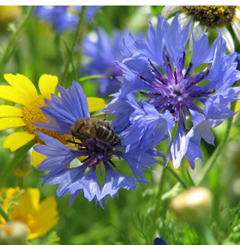
These flowers are NOT found in wildflower meadows! They generally prefer well drained soil and no grass. They’re not perennials, so don’t come back year after year unless you allow them to set seed and then agitate the soil with a hoe or similar. Nor do they flower for long; Cornfield annuals can give a cheerful splash of bright primary colours to wasteland or verge. They’re not as helpful ecologically as perennial meadow species as they don’t persist and only flower briefly. I add some of our meadow mixes as a “nurse” for some added colour and to suppress weeds. ( Update: since the open day we have had quite a few cornflowers pop up, as well as corn marigolds, and more poppies).
Typical cornfield annuals:
Corncockle Agrostema githago (poisonous if eaten and increasingly rare in the wild)
Corn Chamomile Anthemis arvensis
Cornflower Centaurea cyanus
Corn Marigold Chrysanthemum segetum
Scentless Chamomile Matricaria perforata
Field Forget-me-not Myosotis arvensis
Corn Poppy Papaver rhoeas
Perennial wild flower species are often slow to establish.
It is very important that the ground is prepared thoroughly. Once established both the grasses and wild flowers will be easy to maintain but they can take some time to get started. In particular you need to get rid of any invasive weeds like couch grass, docks, nettles and elder. It is, in some cases, worth looking at the ground nearby where you are sowing the seed. For example, if you plant next to a field full of docks then they are going to reseed in your meadow. You can dig the site over with a fork by hand, removing all the weeds but that was not practical for the 50 sqm area we are using so we settled for harrowing it at the end of the summer.
You can over the area with black plastic for a while, or better use cardboard covered with top soil, and plant into the topsoil and let the cardboard rot away. Now we know where the clover and ajuga are growing we will select areas to plant this way in the autumn.
We harrowed the ground but that alone is not enough to remove couch/rye grass. Both of which will choke out most annuals and perennials. For larger areas you may need to spray with a herbicide and then use a rotavator to turn the soil over (if you have the time then it can pay to go through this process twice – but we did not want to use weedkiller). Remove what is there and wait to see what starts to establish, then remove that before planting the seed. That worked O.K. for small test areas. but we wanted to retain existing wild flowers .
Before sowing or planting, the soil should be broken up and be relatively free-draining. It can then be raked over to a firm and fine tilth, as you would for a lawn.
Even on large areas broadcasting will work better than drilling. After sowing, the ground should ideally be consolidated in some way such as by rolling , or by walking all over it.
I experimented with direct sowing of seed onto bare soil, onto harrowed soil, and also mixed with sand, and a separate sowing mixed with spent top soil, and also separate sowings in each month March to May. Don’t overdo this because most wild flows need light to germinate.
Different people advocate different seeding coverage from 2g /sqm to 20g/sqm. It’s still only a small amount of seed per square metre and some seeds are like dust so I mix it in with some sand or earth first to increase the volume, to help spread it more evenly and visibility of what is covered. Broadcast the seed. or if you are establishing a larger area a hand operated lawn fertilizer spreader and avoid windy days!
Many commercial mixes are mixed with bran and grasses and are often from China – specialist U.K. farms cost more but you have more choice for native species and more reliable quality, with mixes available for different types of meadows and soil.
The best times for sowing on the flower, generally March through to May or in the autumn (July through to early October). However, I found that later sowing i.e. early June produced better results – we did have a very wet March- April and a very dry May. Some seeds need cold to germinate. If there is a grass in the bed of 50% or more then seeds are better planted in the autumn when the soil is still warm and the grass has stopped growing.
Both grasses and wild flowers will take some time to get established. You will start to see the real benefit in the second year rather than the first year of establishment even for the annuals. Do not panic if the meadow is disappointing in its first summer -many expert say it takes 5 years.
Guidelines are difficult as each year can be very different. In the first year the meadow may need cutting through the autumn and winter and into the early spring to keep it below 6 inches. Do not cut after mid-March especially if you have cowslips or fritillaries. After mid March leave it and wait until all the summer flowers are over (normally in the early autumn).
Some species will flower twice and you may need to give it a second cut in the late autumn. It should never be cut too short (the blades should be set at about 4” if possible). This level will prevent the broad–leaved plants from being destroyed whilst allowing light and air. You need to remove the grass cuttings but it is worth leaving them for a few days to wilt, so making it less weight to move. If left on the ground and not removed at all they may well kill some of the broad–leaved plants. After the first year in following years the meadow can safely be cut down to 1 to 2 inches in height in the autumn.
There often seems to be conflicting advice abo whether there should be grass in the mix, whether the wild flowers need grass for support and so on. Some flowers like fritillaria and cowslips seem very happy in long grass as does wild scabious, betony, poppies, feverfew etc – but they may struggle to germinate and push their way through so they need to start growing while the grass is short and then the grass can grow up around .
Yellow rattle Rhinanthus minor is an annual with short lived seed… It therefore needs a chance to set seed each year. Cutting or grazing too heavily between April and Mid July will eliminate yellow rattle by preventing it seeding and should be avoided. Traditional meadow management is based around an early August hay cut and provides Yellow rattle with the best opportunity to set seed. For the seed to scatter during the process of haymaking, autumn grazing or mowing or harrowing is also important to keep open the grass sward. This provides new sites for the Yellow rattle to establish in following years.
Yellow rattle populations tend to fluctuate in meadows from year to year. This is a reflection of the balance of health of the Yellow rattle plants and their host plants in any one patch. Yellow rattle establishment is rather unpredictable. Results will vary from one year to another and from one part of a site to another. The reasons for this are not always apparent. An open sward structure seems to be the most important. It also prefers acid soil.
Yellow rattle seed must be sown in autumn as it needs to be chilled through the winter to trigger it’s germination the following spring I left it too late and despite frosts it failed to appear. The most suitable sites for Yellow rattle is grassland of low to medium fertility, and with a balanced sward which is not dominated by coarse vigorous grasses. Prepare for sowing by cutting the grass very short (1 inch) or by grazing hard and open up sites for germination, by harrowing, raking or lightly disking. Aim to create <50% bare soil. Broadcast the seed on to the prepared surface.
This is my key step for this autumn, to get the rattle established. It’s so important that I will also grow some in plugs/pots as a contingency.
It was said to herald the harvest when it set seed. It’s an attractive annual, quick to appear through existing sward in early spring. Yellow Rattle is hemi-parasitic, like Eyebright – a distant relation – and Mistletoe. This mean that is photosynthesises, but also needs nutrients from a host plant. Rhinanthus significantly reduces the vigor of some other plants, including – most helpfully – grasses. Not all grasses though – the more vigorous, coarser species will overwhelm it. If you have lots of the thug in chief – perennial rye grass – in an area where you want to have Rattle, I’m afraid it’s a lost cause. Some plants, like plantains and Ox-eye daisy, have developed their own strategies to resist Yellow Rattle, and do well in swards with large Rhinanthus populations.
Once common but disliked by farmers – unsurprisingly – Yellow rattle is an attractive plant with a yellow snapdragon type of flower which pollinators find helpful too, particularly bumblebees and butterflies. It’s said to represent a cockscomb, hence another of its synonyms.

It can be added to existing grass cut very short and raked or chain harrowed to open it up. If you’re doing this, aim to have at least 50% of the earth showing, and tread in or lightly roll the seeded area to ensure good soil contact. Avoid cutting the seedlings as they appear, and the developing plants will significantly reduce the vigour of grasses, enabling other wildflowers to compete with them more effectively. When they die back they leave a helpful space for other species to use.
Rhinanthus seed has limited viability over time, so it needs fresh seed each year ideally it will self-seed.
Cornfield annuals will not establish very well amongst grass or other vegetation. They ideally need to be sown on weed-free soil. They should be broadcast at a rate of 2 grams per square metre Sow from September to April. After broadcasting roll or consolidate the soil but do not rake or cover the seed –many wildflowers need light to germinate. Some flowers need /benefit from nutrients more than others.
- Autumn sown annual mixes should produce a mass of flowers from June onwards, with poppies, and corn cockle most abundant.
- Spring sowing tends to favour corn chamomile and corn marigold.
My own experience is that these all grow easily in pots, but the field slugs don’t mind when the new shoots appear or how they are grown, they will quickly devour new seedlings they seem to like particularly like wild chamomile.
Small plugs are no use in clay soil, they dry out and leave air pockets around the roots. Even with spot watering only a few cornflowers I potted on to 9cm pots survived. Fortunately there is another batch coming up to plant out for the autumn and some of the wild cornflowers seeds made it through the grass.
I was also unprepared to have plants dug up, The squirrels will bury and dig up the conkers from the overhanging horse chestnut tree. Maybe they were after fritillaria bulbs? Maybe the rabbits find soil easier to excavate. Maybe the pheasants scratched to find worms. I don’t know but there were several instances of mysterious holes. It gave me bare soil to plant out some pots I had grown.
To recap, it is generally difficult to get wild flower seed to establish into existing grassland. General advice is to clear the ground and start again. If the grass is very poor then it may possibly work. You need at least 50% bare soil. Cut the grass back very sharp then harrow or scarify the ground hard
In my case this was a challenge I underestimated that I addressed later by
- some transplanting of flowers from other parts of the farm with the hope that these trial plants will set seed for next year or establish root system, or at least prove which plants have the potential to be sown in future.
- naturalising cowslips, wild primroses, and snakehead fritillaries, and speedwell which like long grass to give the garden a nearly start in the spring – thiss proved very successful.
- to work with what will grow in this meadow of heavy clay soil in full sunlight, with a lot of established grasses ajuga/bugle, red and white clover, buttercups , daisies, ox-eye daisies, knautia, scabious, vetch, speedwell, There are a lot of ox-eye daisy seedlings that should flower next year.
- sample plant trials that feed bees and butterflies and some have taken better than others e.g. feverfew, scabious
- growing plug plants form seeds and combining some into mini gardens in a 1 litre pits with 4 or 5 plugs grown on together and then inserted as one giant plug.
- Poppies appeared a few at a time over several weeks and keep appearing but not en-masse- there will be thousands of seeds for next year.
- Selective late test strip mowing. Not obvious benefit.
- Cornflowers and corncockles are difficult to establish among the grasses but those that came up flowered well. Next year I will do more to clear the grass, and also grow more to a > 9cm pot+ size. That is the minimum to avoid lots of watering when planted out.
Summary
Wildflower plugs are best planted between September and May.
- Water your plugs before planting.
- To remove your individual plant plugs push them up and out using the hole in the bottom of their cell.
- Hold off planting if the soil is dry, hard or frozen.
- Cut any grass very short and rake out any thatch
- Plant plugs at about 5 per sq metre
- Plant at least 3 of any one species near each other
- Once planted keep the plants watered during their first 6 weeks, the most common losses are caused by the plugs drying out just after planting. However, I was surprised at the losses to slugs/snails.
- After planting, when necessary, mow the area of grass containing the plant plugs with your mower blades set at a high setting. Ideally about 4 inches. This is to try and stop the grass growing too tall and covering the young wildflower plants. This will allow them enough light and warmth to build up a good leaf and root system. When they are established stop mowing and let them progress. This was something I intended to do but the rain in April made it impractical. It is quite noticeable that the seedlings grown from seed in the meadow in successive sowings in Mar, Apr, May are all smaller than those sown late May in trays and grown on into plugs.
Plants that prefer soil with a high level of clay content. These plants can tolerate the two extremes of being in baked solid soil in the summer and prolonged dampness at other times. Our meadows are full of bugle, buttercups, daisies, speedwell, wild sweet pea, vetch, and quite a few types of thistles, docks and weeds, and nettles and brambles and lots of native blossom trees that bring in the butterflies.
Autumn Hawkbit
Bird’s Foot Trefoil
Bladder Campion
Coltsfoot
Cowslip
Field Woodrush
Fleabane
Great Burnet
Glaucous Sedge
Gipsywort
Hedge Bedstraw
Lady’s Bedstraw
Lesser Knapweed
Meadow Buttercup
Meadowsweet
Meadow Vetchling
Ragged Robin
Rough Hawkbit
Selfheal
Sorrel
Teasel
White Clover
Yarrow
A selection of plants that will add a fabulous colour feature to any area. The three annuals corncockle (purple), cornflower (blue) and field poppy (red) will flower strongly the first year they are planted before shedding masses of seeds for next year. The ever popular oxeye (moon) daisy adds a nice tone of white and yellow to the mix.
Corncockle
Cornflower
FieldPoppy
OxeyeDaisy
Knautia
Attract a host of wildlife to your garden or area with these plants. Nectar, seeds for birds, hiding places for insects all help this to happen. Ideal for turning a section of garden into a wildlife area.
Betony
Cow Parsley
Cowslip
Daisy
Greater Knapweed
Meadow Buttercup
Moth Mullein
Oxeye Daisy
Primrose
Selfheal
Small Scabious
Teasel
Wild Clary
Wood Avens
A good mix for most soils is to add 20% meadow grasses but not rye grass – I prefer a heavy sow of 10-15 g/sqm without any extra grass-we have enough.
